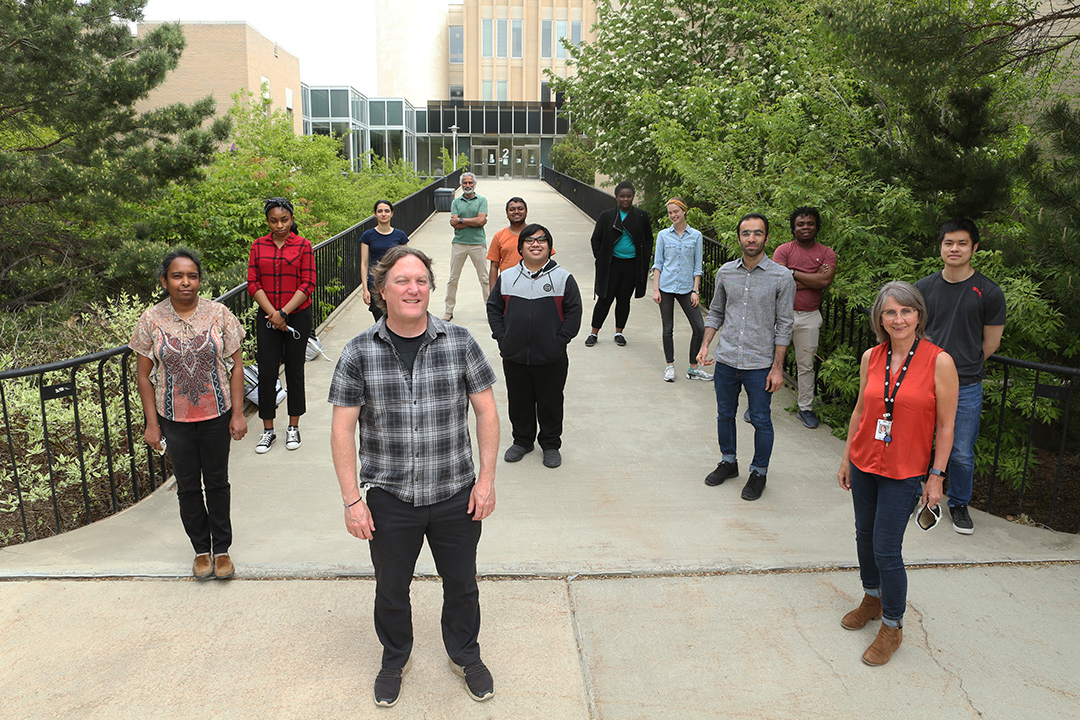
Popular graduate course introduces molecular biology research tools
A highly popular course that provides University of Saskatchewan (USask) graduate students with essential tools for research returned to the Western College of Veterinary Medicine (WCVM) this spring.
By Jessica Colby“Research techniques in molecular biology” is a month-long course that’s taught every other year by WCVM professors, Vikram Misra and Janet Hill, Noreen Rapin and Champika Fernando, two laboratory technicians at the veterinary college, and Tim Dumonceaux, a scientist at Agriculture and Agri-Food Canada.
While the COVID-19 pandemic forced organizers to cancel the course in 2020, a smaller-than-usual group of 10 graduate students from colleges across campus participated in the class throughout the month of May.
“In the biological sciences, it doesn’t matter whether you’re doing research in veterinary medicine or human medicine or agriculture or just biology or cancer research,” says Misra, whose own research focuses on virology and molecular biology. “The tools are the same regardless of what you’re doing.”
Misra joined the WCVM faculty in 1978 and has taught the research techniques course since 1979. Other USask departments ran similar courses in the 1980s, but because it’s an expensive course requiring multiple pieces of equipment and a lot of time commitment, other units stopped offering it.
“I started teaching this course and then I realized it was really popular,” says Misra. “There was a big need for grad students to have something like this.”
During the month-long course, students learn a variety of techniques in molecular biology.
“The first week of the course is what we call ‘molecular biology bootcamp,’” says Misra. “They learn basic things like how to run gels, how to make calculations and so on.”
This course is never the same from year to year. As technologies evolve in the world of molecular biology, so does the course’s content.
“As technology evolves, we incorporate … newer and more relevant techniques into the course,” says Misra. “The second thing that’s really important is that we use techniques that we ourselves are using in the laboratory. We jokingly tell the students that this is the only course they will ever take that comes with a life-time warranty — they can come to us for help any time during their research careers.”
Another perk is that all graduate students who complete the course receive a certificate inducting them into the Royal Society for Bio-Alchemy.
During this year’s course, students learned how to perform a variety of tests.
“They performed various techniques to detect and measure tiny amounts of nucleic acid, either DNA or RNA, and that’s a technique that you can use in diagnostic medicine to see if there is a virus there or how much of a virus is there,” says Misra. He adds that this method can also be used in cancer research to examine genes of concern.
Dumonceaux introduced a new aspect to the course by teaching the students a simplified procedure for detecting DNA or RNA that can be performed in the field.
As well, the students looked at how to make recombinant proteins from animals, humans or plants. With the help of WCVM graduate student Ursula Perdrizet, the class also explored other ways of detecting viruses in tissues, specifically using tissues from a bat infected with a pox virus.
Graduate students Leonie Bettin (wearing jean shirt and yellow headband in above photo) at the Vaccine and Infectious Disease Organization (VIDO) and Justin Naniong (wearing black hoodie in above photo) at the Cameco Multiple Sclerosis Neuroscience Research Centre on campus found that the course was very beneficial to their laboratory skills.
Bettin, a veterinarian originally from Germany, took the course as part of her journey toward a PhD degree in veterinary microbiology.
“I had not so much experience with those techniques and molecular biology,” says Bettin, who has already used one of the course’s methods in her current lab work. “I took this because I wanted to learn the basics to apply it to my research later on.”
The training also showed her how to keep a proper lab book so others who aren’t working on the study can understand her work.
Naniong is a first-year master’s student in the College of Medicine’s Department of Anatomy, Physiology and Pharmacology. Naniong, whose research revolves around multiple sclerosis, has a background in molecular biology techniques but needed a refresher before continuing with his studies.
“The lessons I learned from this course would allow me to enjoy the art of collaborating with others toward a common goal,” says Naniong.
He adds that the course taught him the importance of organization — of having a laboratory-based “mise en place” or a well-ordered lab.
“I did learn to be more conscious of where I store things and place things in relation to myself,” says Naniong. “Also, arranging the things I’d need on the bench to reduce the motions I need to do in order to make it more fluid is important not only to save time but also to reduce contamination and any errors — which is where the ‘mise en place’ comes in.”
After a four-decade run of offering the training at the WCVM, Misra has seen a second and possibly third generation of graduate students taking the course.
“I think we’ve got at least one situation where it’s in a third generation for the original people who took it in the late ’70s, early ’80s,” says Misra. “Their students took it in the ’90s and now their students are taking it."
“To me, that’s an indication of the value and success of the course. It’s been a valuable thing to have to offer.”
Jessica Colby of Montmartre, Sask., is a fourth-year student in the University of Regina’s School of Journalism. She is working as a research communications intern at the Western College of Veterinary Medicine (WCVM) for summer 2021.
